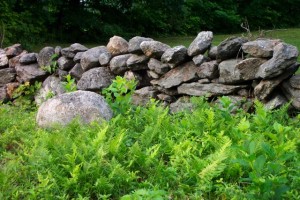
PURPOSE
Sometimes, people tear down old stone walls just to get stones with that time tarnished look. This is generally a bad idea because you destroy an authentic wall for a new one. You can get that time-tarnished look without destroying walls by grubbing stones out of the shallow soil, or by speeding up the aging process on freshly quarried stone. Members of the SWI have given me all kinds of practical tips for speeding up the process, all of which probably work to some extent. Though there is no magic formula, there are very few things you can do to make the process go faster.
THE BASICS
Pending a longer explanation, or citing research done by geochemists, here are the basics off the top of my head, presented in the order you might want to apply them.
- Acidity. Conventional weathering of silicate rock is a chemical reaction between a weak acid (rainwater) and minerals that have cations like calcium, sodium, potassium, manganese, and iron as part of a mineral structure dominated by complex anions formed of silicon, oxygen, and aluminum. What happens is that the weak acid (H+ ions) permanently displaces the cations, tarnishing the wall. Anything that increases the acidity will eat away at the rock more quickly. So, you can apply a weak acid like lemon juice, vinegar, old cider, sour milk, almost anything with a sour taste. Oxalic acid is sold at hardware stores. What this liquid reaction does it to make little gaps and pits for microbes to take hold of. This is particularly important on mica-rich rocks.
- Organic Matter. Much of the tarnished color is due to chemical reactions that are assisted by oxygen-loving bacteria, which use the rock for habitat. They require the presence of oxygen and organic matter for fuel. So, anything that puts little bits of organic matter into into the cracks and pits of the rock will help. Such organic solids are suspended in almost any organic liquid or puree.
- Nutrients. Nitrogen and phosphorous are needed for plant growth. If there isn’t enough, nothing grows. So, to make sure you have some, I recommend a little garden fertilizer if you prefer not to work with manure or noxious materials. An experienced mason I know recommends a product known by the trademark “Miracle Grow.”
- Wetting and Drying. All other things being equal, a wall that is intermittently wetted and dried will age faster that one that is either always dry or always wet because both water and oxygen are both required for silicate weathering and aerobic bacterial respiration
- Sun and Shade. This depends. A wall that is too sunny is often too dry. In contrast, one that is not sunny enough will not develop a photosynthetic lichen cover fast enough. One that is shaded will grow algae, which can decompose to produce acids to make the process go faster. If there’s no algae, however, the cooler temperatures may slow the processes
The requirements above explain why the folk-literature gives us beer, manure, urine, yogurt, buttermilk as magic substances. But be cautious if you go one step further and ask a stone mason his secret. You might get an answer similar to the one the novice fisherman gets from the veteran who doesn’t want to give away trade secrets.

“THEORETICAL” RECIPE
Thinking about the requirements above, and the materials kicking around my house, here is what I would do. It should work in theory, though I haven’t done any experiments.
- Step 1. First, I would watch the weather and wait for a few warm days without rain in the forecast. Then I would brush or spray some non-toxic weak acid on my stone, perhaps a gallon of store-brand vinegar, or something from the hardware store.
- Step 2. Next I would make a tea of some natural organic materials (topsoil, manure, old compost) to get those complex organic chemicals to which backyard ecosystems are adjusted. I would decant the tea into a pail, mix in a handful or two of plant fertilizer and add enough oatmeal puree (or old bread) to make thin slurry of natural organic chemicals and sticky starches.
- Step 3. In dry weather, I would paint the stone with a quick coat of this mixture. After a few days of no rain, I would mist the wall just to keep the process going. The lichens and moss will come in on their own. You might be able to speed the process by breaking some up and scattering crushed lichen on the dry surface as dust, or putting them in a bit of water, puree them, and pour them over a dry surface.
- Step 4. Water periodically (if it doesn’t rain), and let time take its place. Reapply an even weaker acid and paint as you feel so moved.
Please let know if this works. It should work, but I don’t know if it does. If you are masons (better empirical evidence) or geochemists (better theoretically), let me know.
